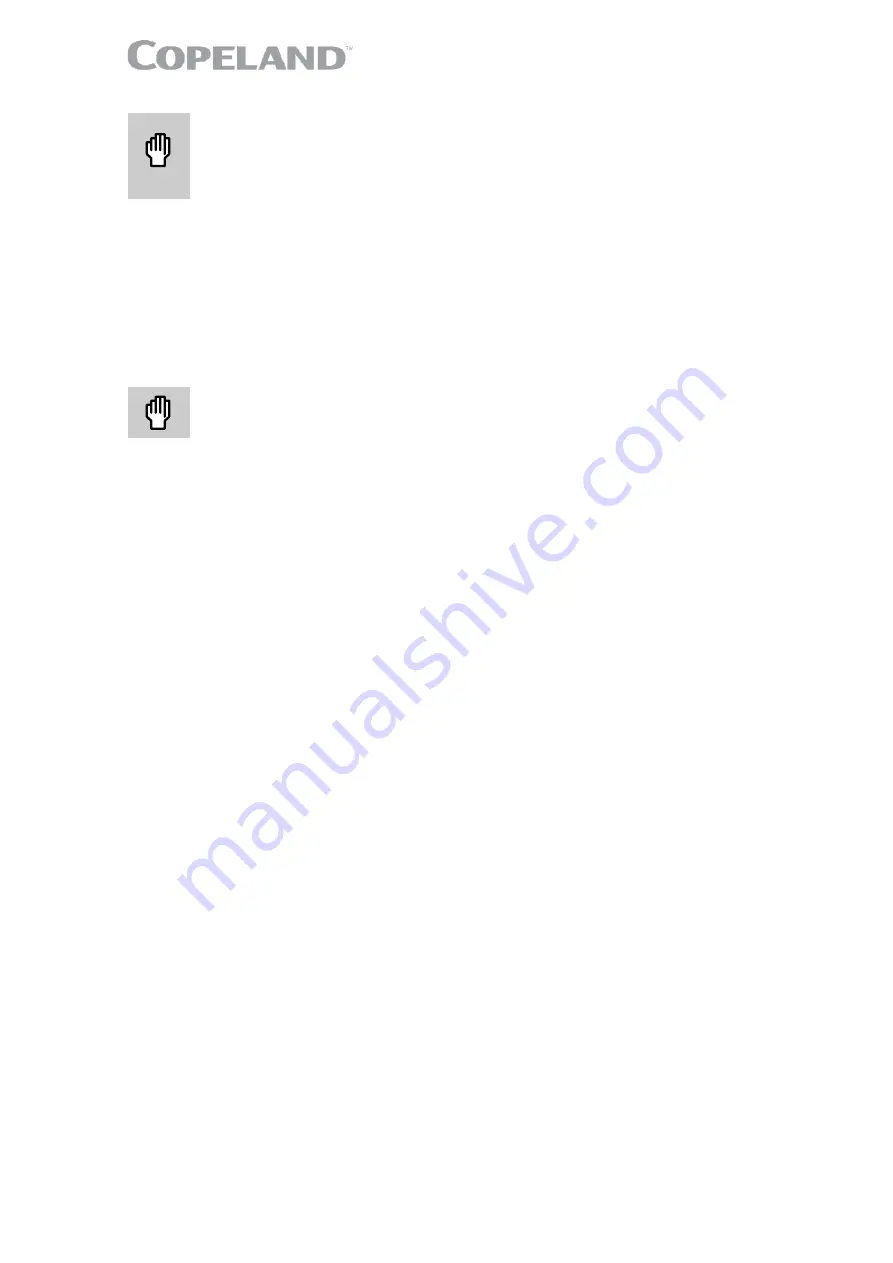
24
AGL_Ref_ST_ZO_E_Rev00
5.11 Deep
vacuum
operation
CAUTION
Vacuum operation! Compressor damage!
Copeland scroll compressors
should never be used to evacuate refrigeration or air-conditioning systems.
Operating scroll compressors in deep vacuum could damage internal motor
parts and lead to unacceptable high temperatures in the compressor housing.
5.12 Shell
temperature
During normal operation, the discharge gas as well as the compressor top shell and discharge line
can reach temperatures up to the maximum discharge gas temperature of 135 °C
– see
section 3.6
"Discharge gas temperature protection"
.
In a failure mode, the discharge gas temperatures can even get higher. Care must be taken to ensure
that wiring or other materials that could be damaged by these temperatures do not touch the shell.
5.13 Pumpdown cycle
CAUTION
Vacuum operation! Compressor damage!
Compressor operation outside
the operating envelope is not allowed.
A pumpdown cycle to control refrigerant migration may have to be used for several reasons, for
example when the compressor is located outdoors without any housing so that cold air blowing over
the compressor makes the crankcase heater ineffective.
If a pumpdown cycle is used, a separate external check valve must be added
. The scroll
discharge check valve is designed to stop extended reverse rotation and prevent high-pressure gas
from leaking rapidly into the low side after shut-off. The check valve might in some cases leak more
than reciprocating compressor discharge reeds, normally used with pumpdown, causing the scroll
compressor to recycle more frequently. Repeated short cycling of this nature can result in a low oil
situation and consequent damage to the compressor. The hysteresis of the low-pressure control
differential has to be reviewed since a relatively large volume of gas will re-expand from the high side
of the compressor into the low side after shutdown.
For pressure control
setting, never set the low-pressure limiter to
shut off outside of the
operating envelope.
To prevent the compressor from running into problems during such
faults as loss of charge or partial blockage, the low-pressure limiter should not be set lower
than the minimum suction pressure allowed by the operating envelope.
5.14 Minimum run time
Emerson recommends a maximum of 10 starts per hour. There is no minimum off time because
scroll compressors start unloaded, even if the system has unbalanced pressures. The most critical
consideration is the minimum run time required to return oil to the compressor after start-up. The
minimum on time becomes the time required for oil lost during compressor start-up to return to the
compressor sump and to restore a minimal oil level that will ensure oil pick-up through the crankshaft.
Cycling the compressor for a shorter period than this, for instance to maintain very tight temperature
control, will result in progressive loss of oil and damage to the compressor.
5.15 Shut-off sound
Scroll compressors incorporate a device that minimizes reverse rotation. The residual momentary
reversal of the scrolls at shut-off will cause a clicking sound, but it is entirely normal and has no effect
on compressor durability.
5.16 Oil level
The oil level should be maintained at mid-point of the sight glass.
Some systems may contain higher than normal refrigerant charges. Systems with large coils, low
ambient condenser flooding, or systems with multiple heat exchangers are among some system
configurations that may require additional lubricant.
During the system development phase, adequate oil return from the system to the compressor should
be evaluated and qualified.
Содержание COPELAND ZO18AG
Страница 4: ...AGL_Ref_ST_ZO_E_Rev00 Appendix1 Tightening torques 32 DISCLAIMER 32 ...
Страница 5: ......
























